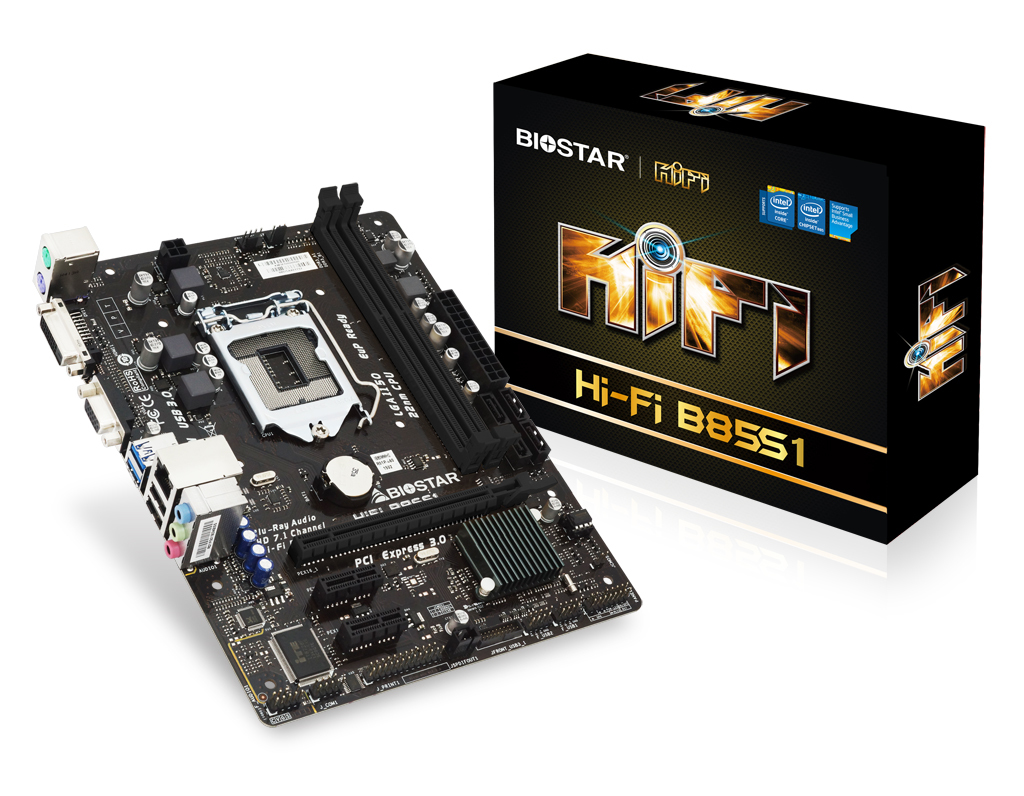Biostar Releases Budget Hi-Fi B85S1 Motherboard
Biostar released a new budget motherboard based on the Intel B85 chipset, the Biostar Hi-Fi B85S1.
The specs are fairly common for a budget motherboard using the B85 chipset. The Hi-Fi B85S1 has two RAM slots, supporting up to 16 GB of total system RAM, as well as a PCI-E 3.0 x16 connection, two PCI-E 2.0 1x connectors, and a meager four SATA 3 connectors.
Like other motherboards in the Hi-Fi series, Biostar attempted to improve the audio clarity of the board by using additional capacitors and placing the audio chipset (Realtek ALC892) on a segmented piece of the motherboard, but it only provides two audio outputs on the rear I/O.
Given that the Realtek ALC892 is capable of 8-channel audio output, there isn't any good reason for Biostar not to include more audio connectors to make use of this feature. The board also doesn't include an SPDIF connection or HDMI connection, so the audio features of this board are rather limited.
The lack of onboard HDMI here is also a poor decision on Biostar's part. Although this isn't an issue for anyone with a dedicated GPU, the fact that this is a budget board means that it's more likely that users will reply on the integrated GPU. VGA and DVI connectors are present, but if you wanted to use this board for streaming movies on a TV, for example, you would also need to have speakers instead of just using HDMI.
The back of the board has two USB 3.0 ports and two USB 2.0 ports, which might be a little light for some users, but the Hi-Fi B85S1 also features a USB 3.0 header and two USB 2.0 headers to help compensate for the lack of ports.
The Biostar Hi-Fi B85S1 has an MSRP of $59 USD, but there's no word about a release date.
Get Tom's Hardware's best news and in-depth reviews, straight to your inbox.
Follow Michael Justin Allen Sexton @LordLao74. Follow us @tomshardware, on Facebook and on Google+.
-
Rookie_MIB It may not necessarily be the case that external speakers would be required for HTPC use. My ASRock Q1900M board has triple output (HDMI, DVI, and VGA), but imagine my surprise when I connected a DVI -> HDMI cable (DVI end on the mobo) and I had sound coming from my TV.Reply
Some DVI outputs will output sound, it's possible that Biostar implemented that instead of adding connectors. -
Shankovich Don't get the two audio out ports if they went through all that effort to isolate the DSP either...but as for on board connectors, it saves cost if they take them out. This looks like a board targeting someone who is going to make a medium/ medium high gaming rig with a non k-series CPU. My only concern is really the amount of power phases for the CPU. I know B85 is business oriented, but again, why the effort for the DSP? Makes me think it targets mid range gamers.Reply -
f-14 ReplyIt may not necessarily be the case that external speakers would be required for HTPC use. My ASRock Q1900M board has triple output (HDMI, DVI, and VGA), but imagine my surprise when I connected a DVI -> HDMI cable (DVI end on the mobo) and I had sound coming from my TV.
DVI single link doesn't output sound, all dvi ports after dvi single link (1.0) out put sound there's dvi 1.2(sound) 1.3 1.4, .3 and .4 also carry internet if i remember correctly. the difference is in the pins in the cable ends a gap in the middle means it's dvi single link 1.0
hdmi is useless and on it's way out the door, biostar and all manufacturers should ditch the onboard vga ports and save themselves money. if you need vga still, there's adapters that are more than likely cheaper to include if needed. vga needs to die like the floppy port, but manufacturers keep dragging them out
Some DVI outputs will output sound, it's possible that Biostar implemented that instead of adding connectors. -
adpo maybe the realtek has an 4-per-channel dual mono implementation similar to common implementations of the audiophile grade es9018 8-channel chip?Reply -
Lawrence Sinanan This board has a market; the budget gamers who rather spend their money where you get the most returns; Video Card. They are going to be rocking head phones most of the time so why put rear ports that you won't use. A SSD, large hard disk and (optional) optical drive still leaves you with a free SATA port for a case with E-SATA adapter. Not to mention just enough USB connectivity for most people. Hell, it even has PS2 for people like me that held on to there 20 year old mechanical keyboard. The only problem I see here is the brand that has been less than reliable for the last few PC I built with them. I encourage all manufactures to think logically and strip out the stuff people won't use to pass on the savings.Reply
